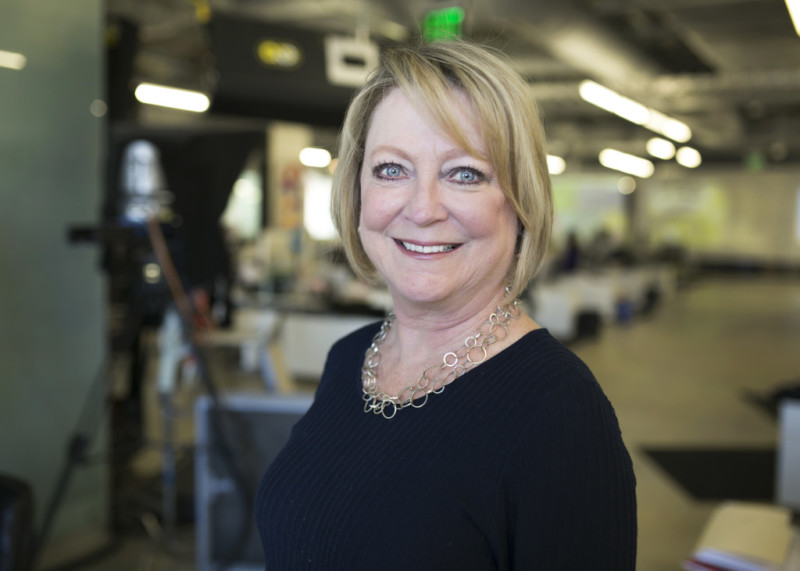Sign up for the daily CJR newsletter.
For two years starting in 2009, Anne Galloway worked 80 to 90 hours a week reporting on the Vermont legislature, without pay, hoping she could breathe life into a new nonprofit focused on investigative reporting.
Today that nonprofit, VTDigger, has a staff of 19, an annual budget of $1.5 million, and aspirations of reaching the $2 million revenue mark by 2021. By one measure, that makes VTDigger the largest investigative reporting nonprofit in the country that is focusing on local or state news. Remarkably, it has happened in the nation’s second smallest state.
Galloway’s gritty success story is a case study of what can be achieved by a philanthropy-driven news organization specializing in investigative reporting. And it’s not the only example.
In San Diego, Lorie Hearn (more from Hearn here) has also been moving into $1 million territory with inewsource, like VTDigger an eight-year-old nonprofit. The key to inewsource’s success: a collaboration with KPBS, the public TV and radio outlets in San Diego.
TRENDING: Don’t blame the election on fake news. Blame it on the media.
At least five other investigative reporting nonprofits have topped $500,000 in annual revenue: City Limits in New York City, the New England Center for Investigative Reporting, Oklahoma Watch, the Wisconsin Center for Investigative Journalism, and Searchlight New Mexico.
The Institute for Nonprofit News lists more than two dozen local or state investigate reporting operations, with total 2016 revenue approaching $9 million. Although many of these news organizations had growing pains, their continued overall growth offers hope for the future of investigative reporting, even as it languishes at many downsizing newspapers.
“People are seeing what’s happening in their local newspapers,” says Galloway, VTDigger’s editor. “We now have more reporters than the Rutland Herald. It’s terrible what’s happening in the industry. But we are one solution.”
These investigative reporting newsrooms remain considerably smaller than the largest state or local nonprofits such as the Texas Tribune, which had 2016 revenue of $6.9 million, according to its IRS filing. (Although the Tribune and many other larger operations do investigative reporting, this story focuses on the local and state nonprofits for which investigative work is the founding or current mission.)
It’s terrible what’s happening in the industry. But we are one solution.
One reason for the size difference is that most investigative nonprofits were launched without the benefit of large individual donors.
The first-generation founders of these organizations were often veteran investigative reporters whose skills had little to do with soliciting wealthy donors. As well, some potential contributors were skittish about supporting sometimes-controversial reporting projects. “It takes a unique type of donor to write a check and scribble in the memo line, ‘Cause some trouble,’” says Trevor Aaronson, executive director of the Florida Center for Investigative Reporting.
But things have started to turn. Many investigative reporting shops are finding that donors, including people of wealth, have become alarmed by the erosion of newspaper resources and by attacks on the press from President Trump, and are ready to invest. Although these nonprofits customarily launched with foundation money, some now collect a majority of their revenue from individuals.
Many are focusing on building a “major donor” class. For example, the Wisconsin Center for Investigative Journalism recently announced its Watchdog Club, which requires contributions of at least $1,000 per year and will be key to its plan to reach $1 million in annual revenue.
And everyone is on the lookout for the kind of donation Galloway recently landed: a $1 million pledge over five years from Vermont Country Store owner Lyman Orton and his wife, Janice Izzi. VTDigger will use the money for tech upgrades and business operations.
TRENDING: Reddit flexes its muscle over net neutrality
Of course, not every nonprofit is so successful. The investigative reporting sector has huge challenges—the time-consuming nature of many reporting projects, for example, which works against visibility, and the unpredictability of foundation grants, which causes budgets to lurch up and down. A number of investigative reporting nonprofits have not survived; many struggle to stay in business.
“It’s the hardest thing I’ve ever done in my life,” says Robert McClure, a veteran investigative reporter who helped launch InvestigateWest in Seattle and continues to lead it. InvestigateWest has experienced the seesaw ride of foundation funding in recent years, but McClure says he is optimistic that growth in individual donations will help boost next year’s budget to nearly $300,000.
“The nonprofit news movement needs to capitalize on the unique moment in which we find ourselves in US history,” says McClure.
Several aspects of investigative nonprofits’ early success are hopeful indicators about this sector’s future. One is that they’ve been able to thrive in small states like Iowa, New Hampshire, and Maine, as well as in large states. Three of the 10 largest investigative operations are in Oklahoma and New Mexico. Searchlight New Mexico, which launched just last year, already has reached $500,000 in revenue.
Meanwhile, San Diego’s inewsource has demonstrated that it’s entirely possible for two million-dollar local nonprofits to exist in the same city.
Lorie Hearn and San Diego’s inewsource
Lorie Hearn was well aware that San Diego was home to one of the most prominent news nonprofits, Voice of San Diego, when she decided to establish an investigative reporting operation there in 2009. Hearn had extensive experience with watchdog journalism as metro editor at the San Diego Union-Tribune, and figured an investigative outlet would be a good complement to the broader civic focus of Voice of San Diego. But she had little understanding of what it would mean to attract the necessary philanthropy for a second news nonprofit.
“I was completely naïve,” she says. “I didn’t know anything about raising money.”
But it turns out her original premise was correct. Hearn says inewsource is projected to reach $1.1 million in revenue in its current fiscal year, which ends next summer. The nonprofit’s turning point came in 2011, when it struck a partnership with KPBS, operators of the public TV and radio stations in San Diego.
“We kind of became their investigative reporting arm,” says Hearn. “One reason we had such success is our name started getting out to the public… We’re now reaching 1 million people a week.”
Initially inewsource relied on foundation money, but Hearn says her pivot to targeting individual donors took off last year with the popularity of the journalism movie Spotlight.
Its news staff of six, located in the KPBS building, is heavily oriented toward its partners’ broadcast needs. Recent investigations reported on pollution problems at a major natural gas storage facility and the surprising growth of diabetes-related amputations in California. In 2014, its project on the thousands of Californians being kept alive by machines was aired nationally by PBS, and was a finalist for an Emmy.
Initially inewsource relied on foundation money, but Hearn says her pivot to targeting individual donors took off last year with the popularity of the journalism movie Spotlight. Anyone contributing $1,000 a year or more is now a member of inewsource’s Spotlight Club, whose ranks should reach 130 by the end of this year. Individual donations now make up more than half of inewsource’s revenue.
Hearn is hoping Hollywood-inspired lightning strikes twice. Later this month will come the release of The Post, chronicling The Washington Post’s victory in the Pentagon Papers case.
Hearn figures the timing will be perfect to lure prospective Spotlight Club members to the group’s meeting early next year. Among the speakers: former Post executive editor Len Downie.
Anne Galloway and VTDigger
Galloway says she doesn’t regret her two years doing virtually nothing but trying to build VTDigger. But she acknowledges it came with sacrifices. “Hard on my husband, hard on my family,” she says. “I wish I had started with more money because it took me three years to demonstrate proof of concept.”
But by her fourth year, VTDigger was pushing revenue well into six figures with a combination of corporate sponsorships, individual donations, and foundation grants. In more recent years VTDigger has been building its earned revenue category, something virtually all news nonprofits are striving for. Last year VTDigger made more than $55,000 selling its daily newsfeed to Vermont news outlets.
VTDigger branded itself at birth as an investigative reporting nonprofit, but over time it has expanded its portfolio to breaking news and explanatory journalism. It has the state’s only Washington, DC, correspondent, and recently Galloway put new resources into covering southern Vermont.
VTDigger now produces 8 to 12 stories a day, and Galloway says that output has been central to its success. “I think one mistake investigative reporting organizations make is thinking they can be successful doing only a few projects a year. You need to be in front of people a lot more than that.”
But it’s the investigative reporting Galloway highlights in discussing VTDigger’s indispensability: a town clerk’s embezzlement of more than $1 million; the toxic-waste legacy of Chemical Fabrics Corp. in North Bennington; the site’s ongoing coverage of visa-law fraud at Vermont ski areas.
Galloway’s focus in 2018 will be to use the new $1 million pledge (over 5 years) to strengthen its business operation, so it can meet budget goals of $650,000 in sponsorships and $500,000 in donations from readers. If she’s successful, VTDigger should reach $1.7 million in revenue next year and continue adding positions to its news staff.
And Galloway has her eyes on a new target. Using legacy-media language, she says that outside of the Boston Globe, she aims to make VTDigger “the best newspaper in New England.”
Note: Nonprofits selected from member directory of Institute for Nonprofit News. Included are local or state nonprofits for which investigative work is the founding or current mission. Data are either self-reported or taken from IRS 990 filings. The data on Colorado Independent comes from 2015 IRS filings.
Editor’s Note: This article is part of a series of stories that is running in CJR about the rise of local and state nonprofit news sites and their pursuit of individual philanthropy. It is funded by the University of Southern California’s Center on Communication Leadership and Policy, located at the Annenberg School for Communication and Journalism. Its director, Geoffrey Cowan, has been focusing on nonprofit news since 2008.
ICYMI: What we found when we asked newsrooms about sexual harassment
Has America ever needed a media defender more than now? Help us by joining CJR today.









